Images of Research Contest
Knowledge is beautiful. USask researchers know it better than anyone.
Each year, University of Saskatchewan students, staff, faculty and alumni capture the impact of their research, scholarly and artistic works—demonstrating how their work made a difference to society, the economy and global challenges—with an image and a simple description.
The results are nothing short of amazing.
About the contest
Staff, students, faculty and alumni are encouraged to begin gathering photos of their USask-affiliated research, scholarly and artistic work for the 2026 Images of Research Contest!
Submission timelines will be announced in January, 2026. Please consult the 2026 Terms of Reference below for full contest details and eligibility requirements.
Looking for inspiration? View the 2025 contest submissions below.
Images may be submitted into one of five categories:
- From the Field: Images which demonstrate the researcher’s experience doing field work anywhere in the world
- More than Meets the Eye: Images which reveal the subject in greater detail than is possible with the human eye (eg. x-rays, creative expression, microscopic images, computer models, etc.)
- Community Impact: Images which represent research done with partners that benefits communities.
- Research in Action: Images which demonstrate what the researcher's work is all about
- Arts in Focus: Images which represent the researcher’s artistic work with a focus on music, drama, art and art history, and the humanities
Winners will be selected within each category, and also across all submissions for:
- Viewers' Choice: Images which received the highest number of votes during a public voting period
- Best Description: Images accompanied by the clearest, most informative and most vibrant descriptions and titles
Submissions are judged by mutlidisciplinary panels comprised of students, faculty and staff across campus. An Grand Prize winner, and within each category, a winner and runner-up, are selected on the basis of:
- Creativity
- Aesthetic appeal of the image
- Degree to which the image showcases the entrant's research
- Clarity and creativity of the written description and title in conveying the research impact
Questions about the Images of Research contest?
2025 contest results
Organized by USask's Research Profile and Impact team, the 11th Annual Images of Research contest featured:
- Nearly 100 image entries across five submission categories, from students, faculty, staff and alumni representing 11 USask colleges and schools.
- Seven judging panels, comprised of faculty, staff and students from across campus.
- Nearly 2,500 public votes for 'Viewers' Choice.'
- Over 20,000 views of the contest online.
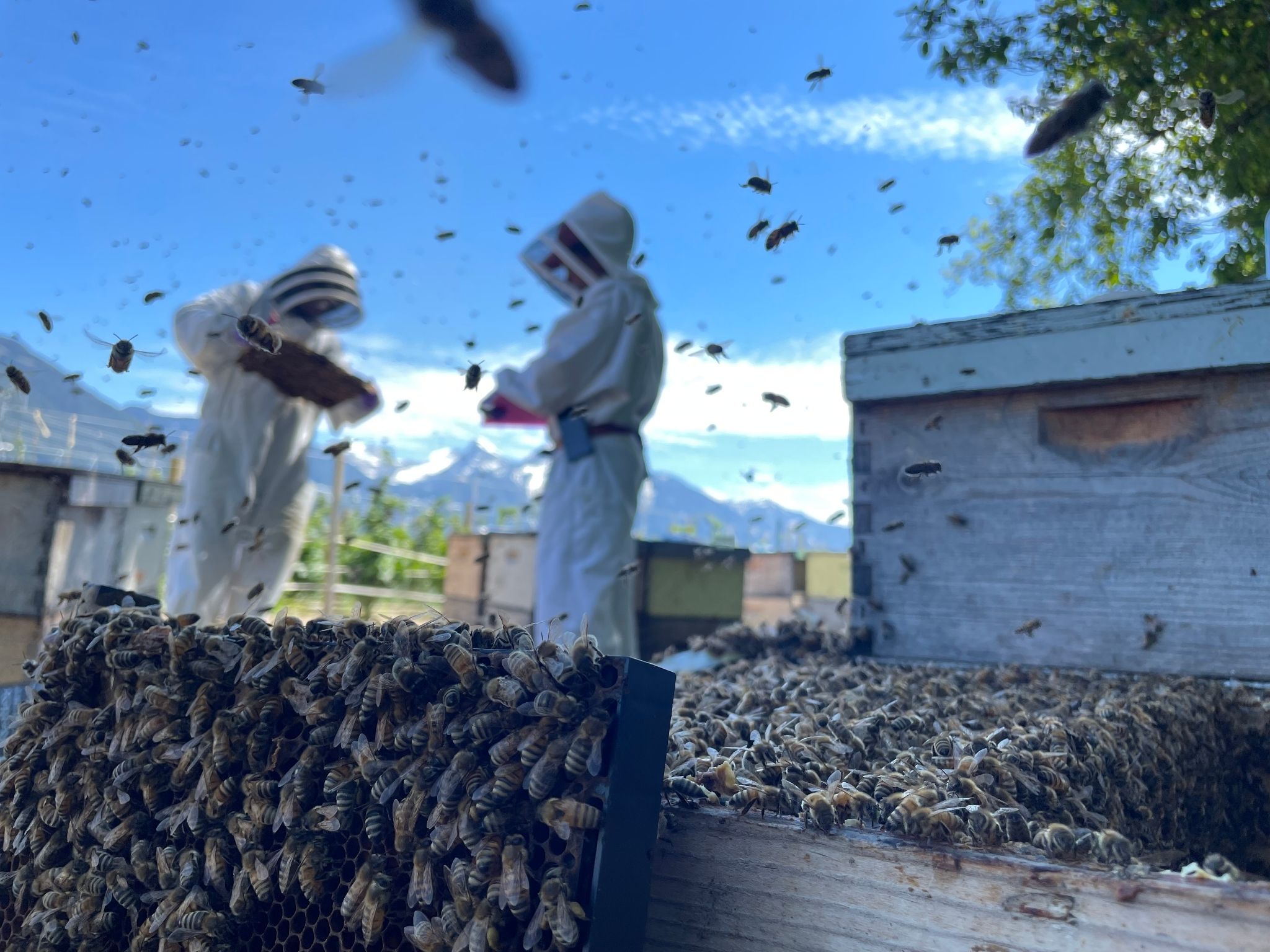
A Busy Day in a BC Bee Yard
By: Maria Janser, Undergraduate student, Western College of Veterinary Medicine
(Winner, Grand Prize)
An early day of field work in a honeybee yard that is pollinating a nearby cranberry field. This farmland is nestled in a valley surrounded by snow-capped mountain peaks. The sun glistens on the mountains and the bees fly frantically across the image. The foreground of the picture gives a window into an open colony, highlighting the bees on an individual frame. In the distance, a pair of researchers are analyzing frames for disease, strength and health. This image captures the frenzy and the beauty of honeybee field research.
Funding: NSERC Undergraduate Student Research Award (USRA), Saskatchewan Beekeepers Development Commission, British Columbia Blueberry Council, BASF, Sask Oilseeds, Manitoba Canola Growers, Syngenta, NSERC, Mitacs, Government of Saskatchewan, Results Driven Agricultural Research, British Columbia Honey Producers Association, Alberta Beekeepers Commission, Ontario Beekeepers' Association, Les Apiculteurs et Apicultrices du Québec, New Brunswick Beekeepers Association, PEI Beekeepers’ Association, Syndicat des Producteurs de Bleuets du Québec, New Brunswick Wild Blueberries, Wild Blueberry Producers Association of Nova Scotia, PEI Wild Blueberry Growers Association
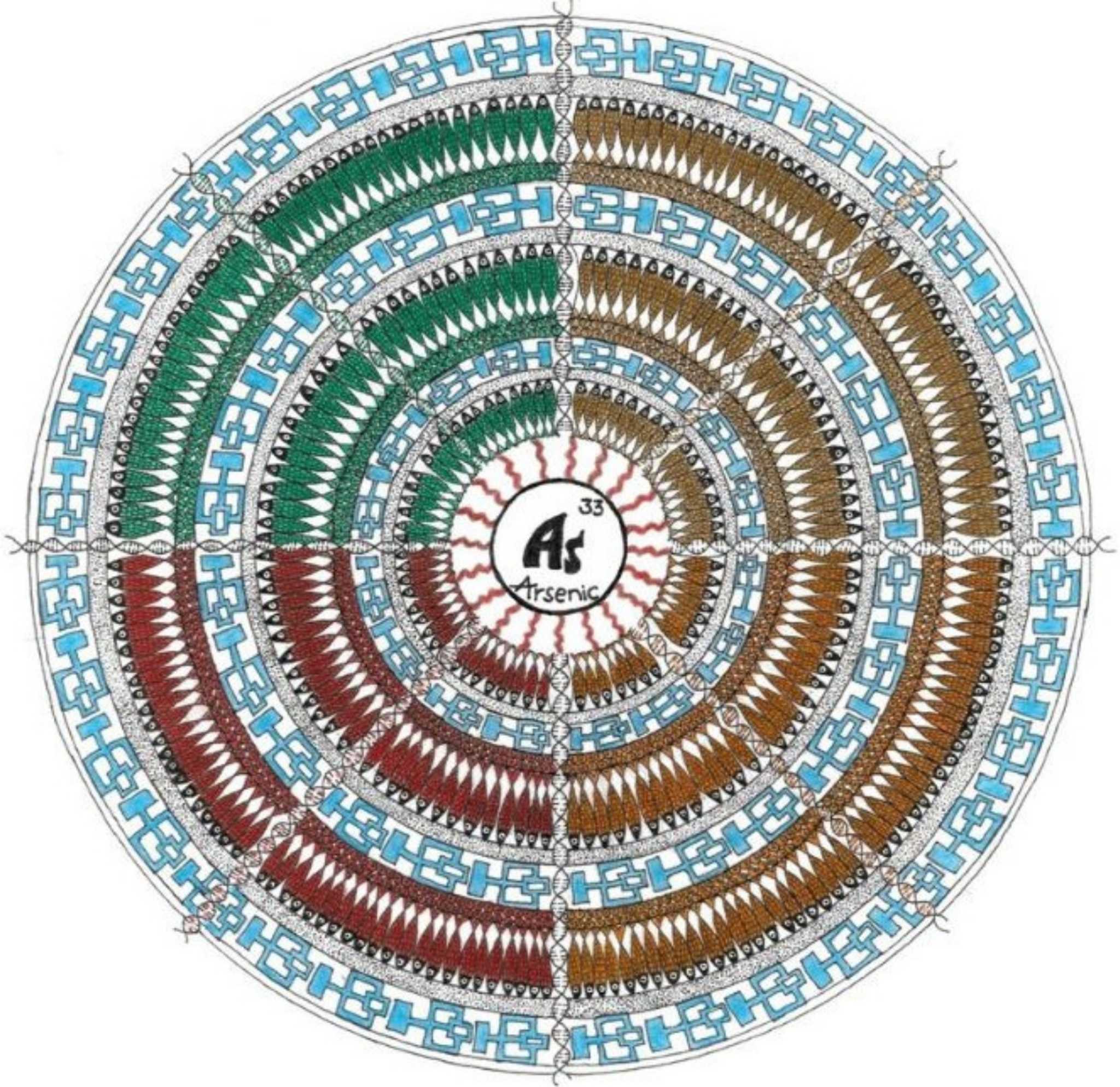
Silent Inheritance:
The Multigenerational Effects of Arsenic
By: Mahesh Rachamalla, PhD student, Department of Biology, College of Arts and Science
(Winner, Arts in Focus)
This mandala art vividly illustrates the transgenerational impact of arsenic toxicity, revealing how chronic exposure in zebrafish induces cognitive impairments that persist for up to three generations. The color scheme represents varying arsenic doses: green for control, while gray and red indicate increasing exposure levels. At the core, the maze-like pattern reflects the behavioral test used to assess learning and memory, while the interwoven DNA strands symbolize how these effects are inherited through epigenetic modifications, particularly altered DNA methylation patterns. This artwork serves as a compelling reminder that environmental toxins do not merely affect individuals, they shape the neurological and cognitive health of future generations, underscoring the long-term and often unseen consequences of pollution.
Funding: NSERC
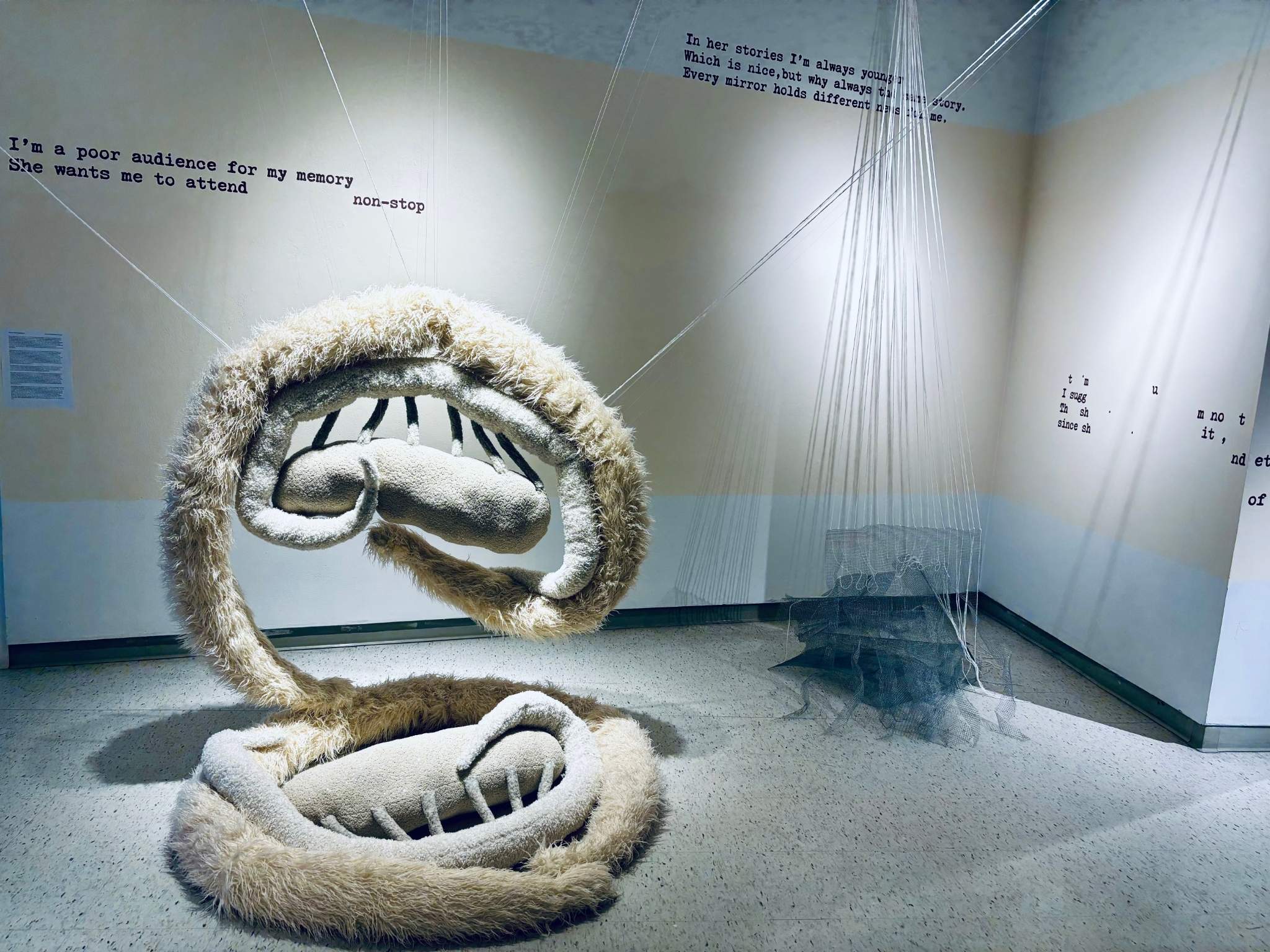
Synaptic Threads:
Stitching Identity Through Time
By: Gabriela Sieminska-Hauck, MFA student, School for the Arts, College of Arts and Science
(Runner-up, Arts in Focus)
This textile installation examines the body as a dynamic archive, where memory, sensory experience, and identity converge. By magnifying the limbic system—specifically the hippocampus, amygdala, and olfactory bulb—the work materializes the neurological structures that govern memory formation and emotional resonance. The olfactory bulb’s personal significance, linked to childhood and homeland, underscores the deeply embedded nature of sensory recollection. The installation employs textiles and wire to embody the tension between memory’s permanence and its mutability, while fragmented poetry evokes the selective and nonlinear nature of remembrance. Through immersive spatial composition, the work interrogates how internal archives shape selfhood, positioning memory as both a physical imprint and an ethereal construct that defines human experience.
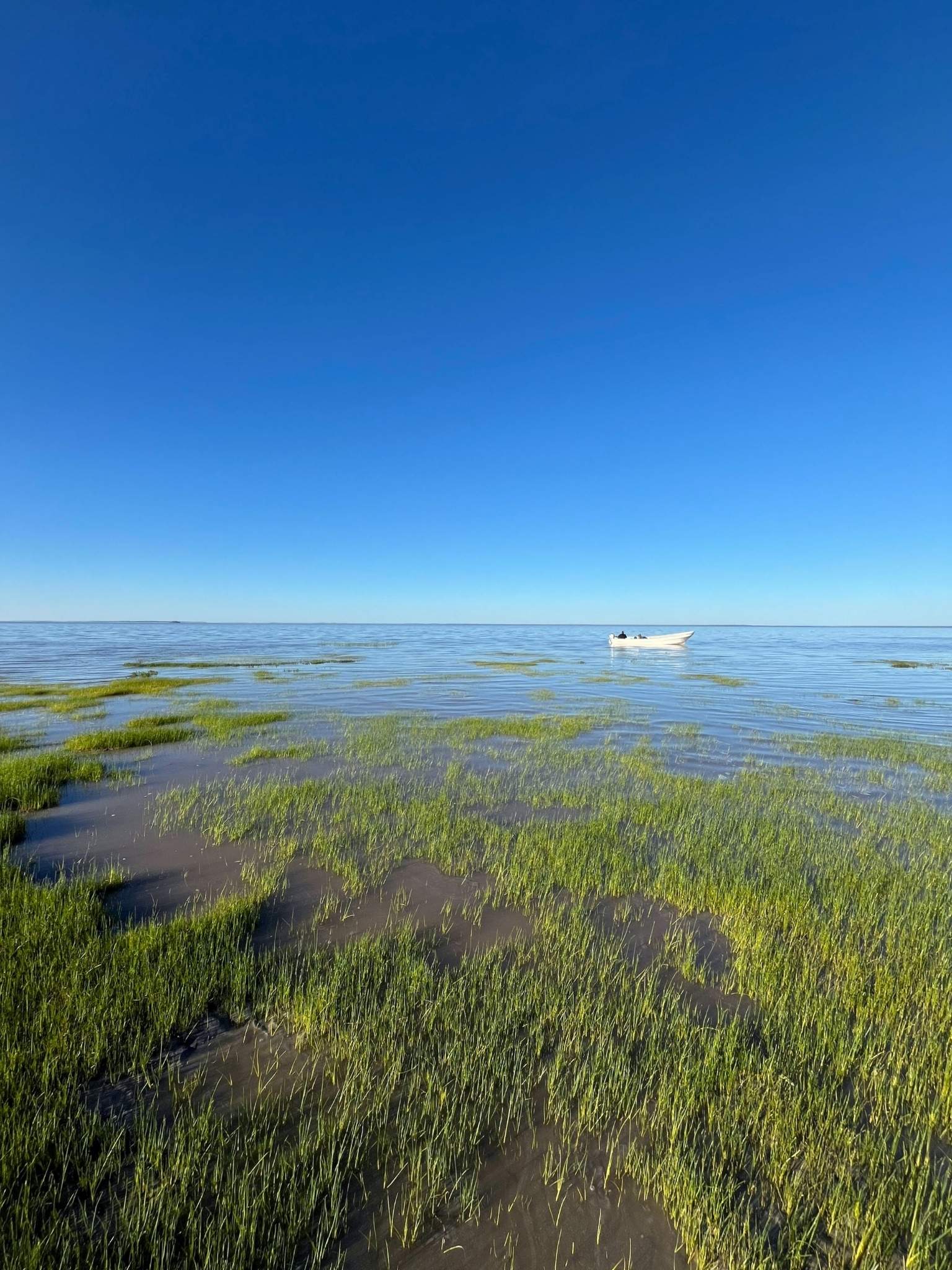
Wînipekw on the Rising
By: Lindsay Carlson, PhD student, Department of Biology, College of Arts and Science
(Winner, Community Impact)
Nearly half a century after work began on the James Bay hydroelectric project, the Eeyou (Crees of Northern Quebec) are working to understand how hydroelectric development and the region’s rapid isostatic rebound are affecting the plants and animals of their traditional territory. Spring goose break is perhaps the most important Eeyou cultural activity, and hunters have noticed a decline in waterfowl passing through each season. We partnered with land users, tallymen, and regional agencies to understand how goose habitat quality and habitat use has shifted following drastic changes to the bay. Cree land user, Dwayne Wistchee, keeps his boat in deeper water while I sample intertidal vegetation used by staging waterfowl on a rising tide.
Funding: Niskamoon Corporation, Eeyou Marine Region Wildlife Board, Arctic Goose Joint Venture, Ducks Unlimited, Dr. Bruce D.J. Batt Fellowship in Waterfowl Conservation, Dean's International Doctoral Scholarship, Dennis Raveling Scholarship for Waterfowl Research
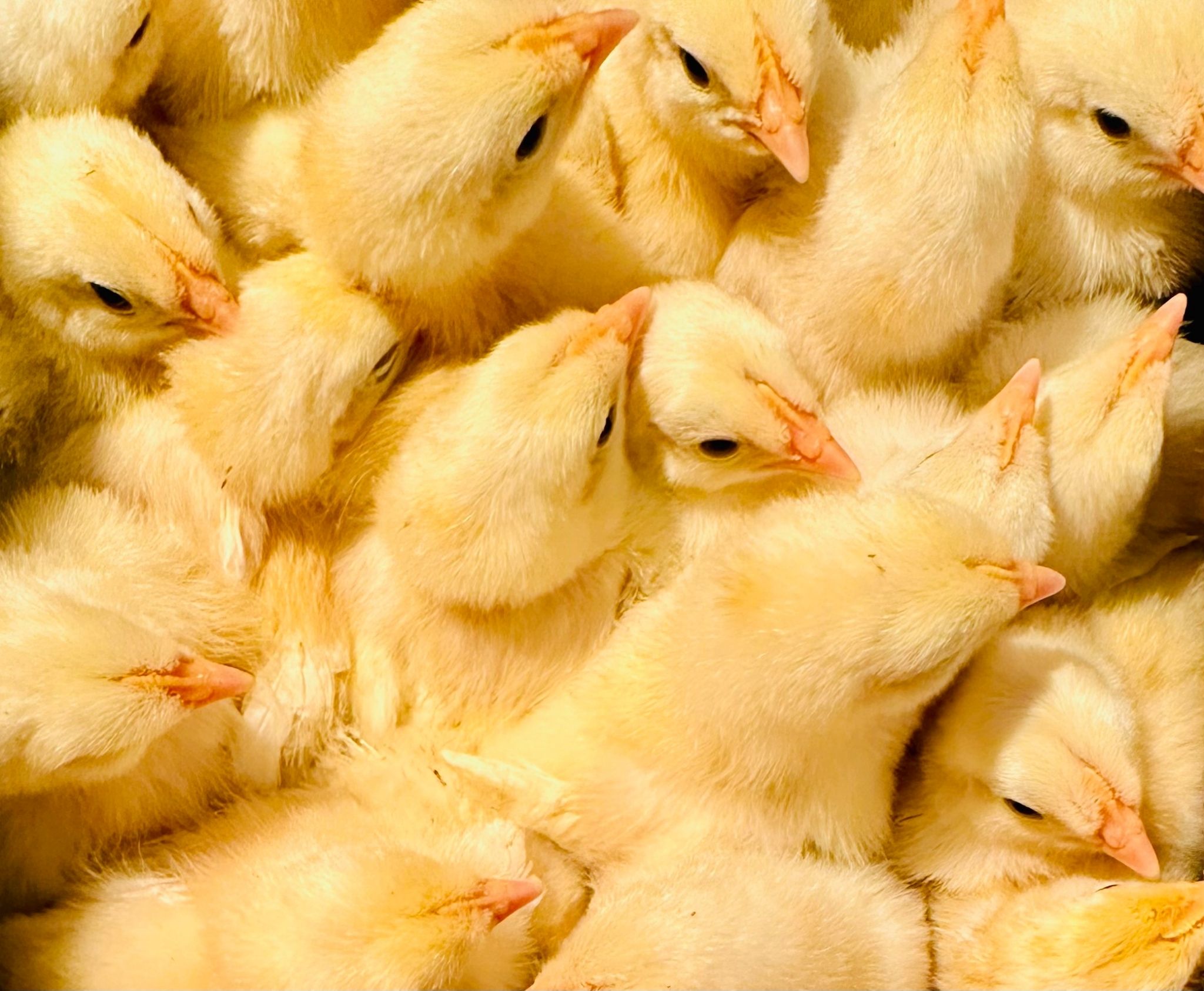
Combatting Anti-Microbial Resistance for Safer, Healthier Food
By: Mihiprabha Rathnayake, PhD student, Veterinary Pathology, Western College of Veterinary Medicine
(Runner-up, Community Impact)
In a quiet hatchery, eggs are carefully incubated, each one holding the potential for a healthy chick. But in my research, something extraordinary happens—these eggs are sprayed with probiotics, a natural force that begins its work even before the chicks hatch. The result? Chicks that are stronger, more resilient, and protected from harmful bacteria. The intestines of these chicks are colonized with good bacteria. No antibiotics, no chemicals—just nature’s own defenders at work. As they grow, these little birds become symbols of a future where healthier poultry replaces the need for antibiotics, and safer food reaches our tables.
Funding: RDAR, NSERC CRSNG, Mitacs, Chicken Farmers of Saskatchewan, Canadian Poultry Research Council, Government of Saskatchewan - Ministry of Agriculture
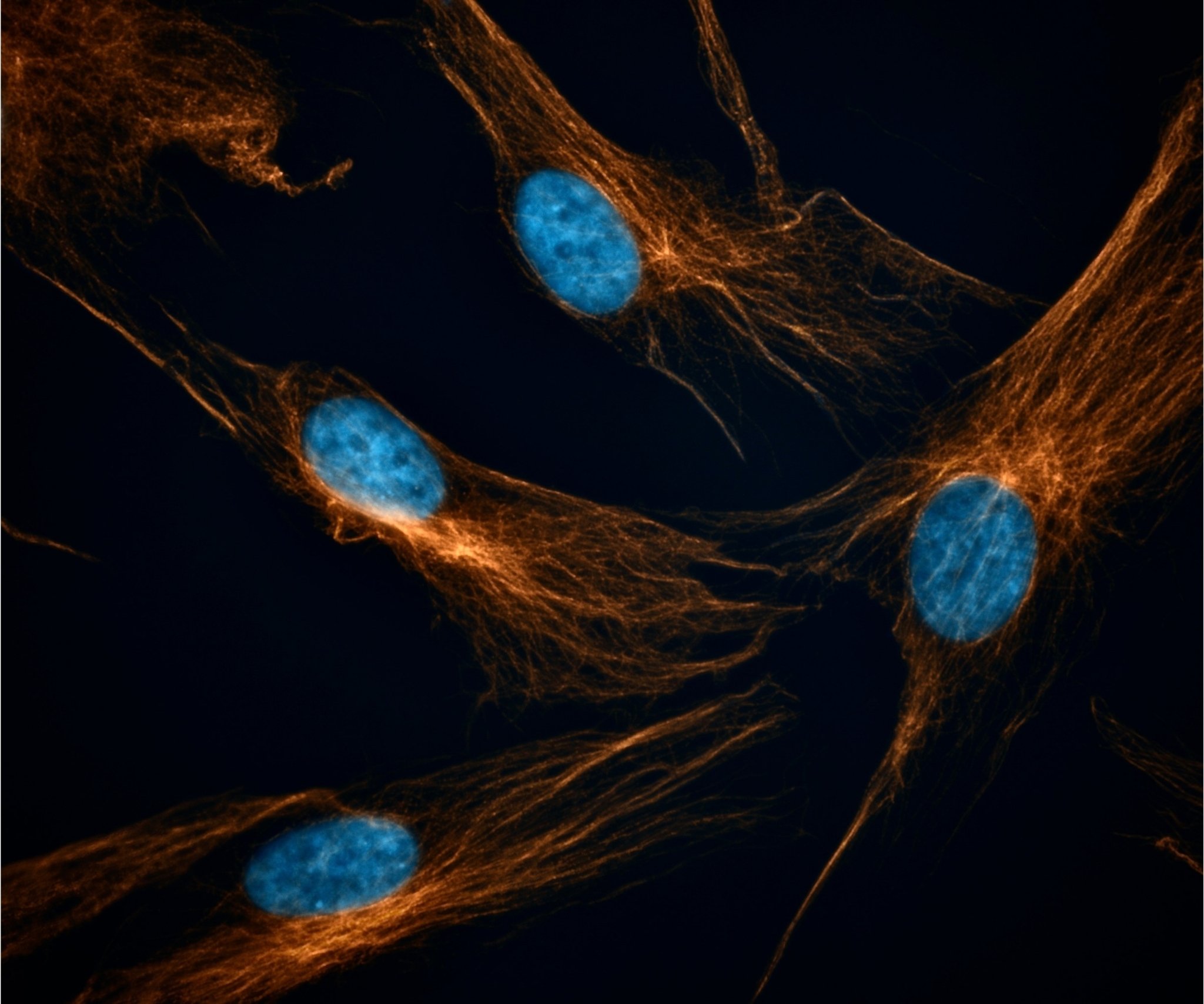
The Hidden Universe Inside Us
By: Asmaa Fadl, PhD student, College of Dentistry
(Winner, More than Meets the Eye)
“You think you are a small entity, but within you is enfolded the entire universe.”– Rumi. What we see under a microscope can be just as vast and complex as the universe itself. This fluorescence microscopy image captures human gingival fibroblasts, the main cells that build connective tissue in the gums. β-Tubulin (orange), a structural protein, forms the cellular framework, stretching like distant galaxies, while the nuclei (blue) resemble scattered stars. This microscopic landscape mirrors the infinite patterns of the cosmos within the fundamental building blocks of our bodies. Beyond its striking resemblance, this image reveals key insights into the structure and behavior of fibroblasts in diseases like fibrosis and cancer, deepening our knowledge and ultimately guiding new treatment approaches.
Funding: CIHR, Supervisor: Dr. Andrew Leask
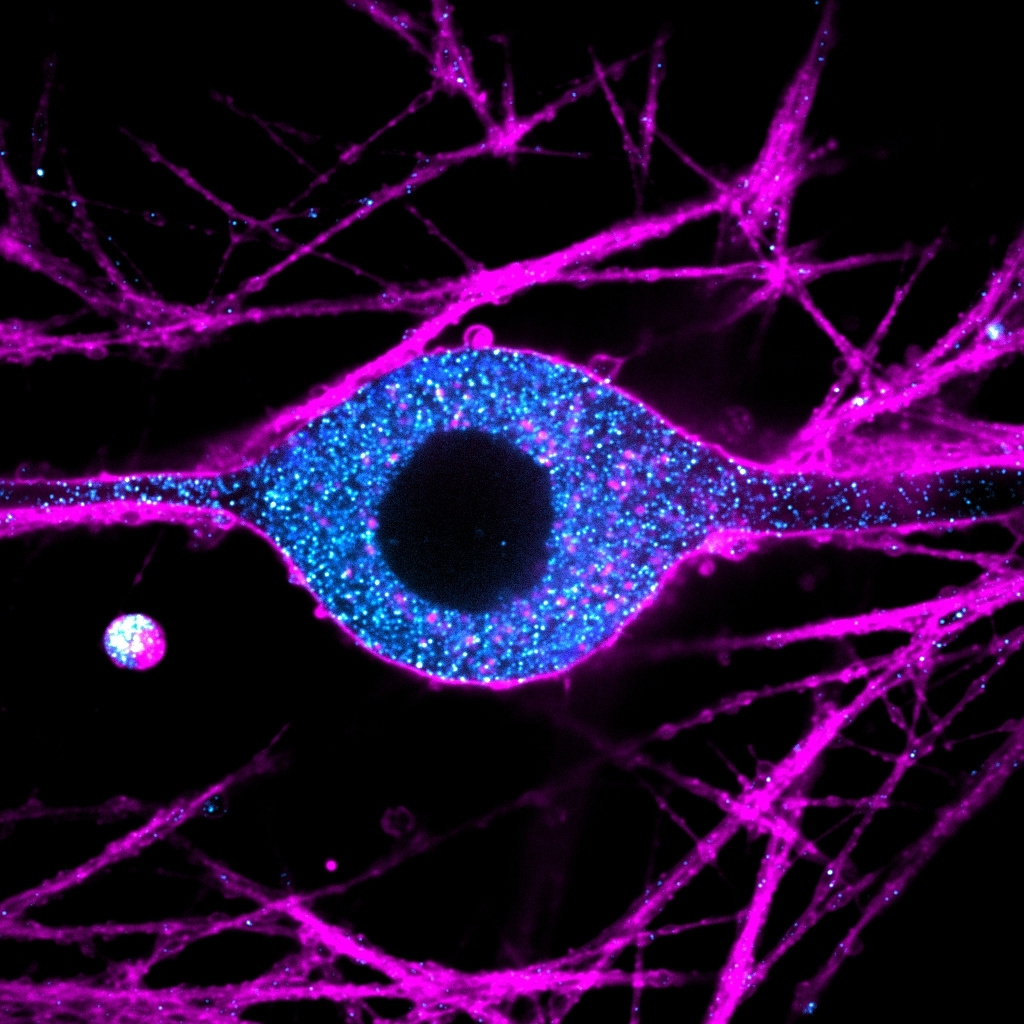
Be Careful of What You are Doing, the Cells are Watching
By: Minh Vu, Master’s student, Department of Anatomy, Physiology and Pharmacology, College of Medicine
(Runner-up, More than Meets the Eye)
This image offers a unique glimpse into the intricate relationship between nicotinic receptors (nAChRs – dark blue) and serotoninergic type 3 receptors (5HT3Rs – light blue) within a superior cervical ganglion (SCG) neuron. Although 5HT3Rs are known to be highly expressed alongside nAChRs in SCG neurons, the underlying reason remains a mystery. The composition forms an evocative "eye" shape and a dynamic scene: a dense flow of axons encircling an SCG neuron, with a tiny vesicle appearing as a "tear drop". This artistic element evokes the sensation of the "eye" weeping, perhaps from the cellular stress induced by the intense axonal traffic. Scientifically, this tiny vesicle is on a vital journey, carrying signals to communicate with other neurons! Membrane lipid rafts (pink).
Funding: NSERC
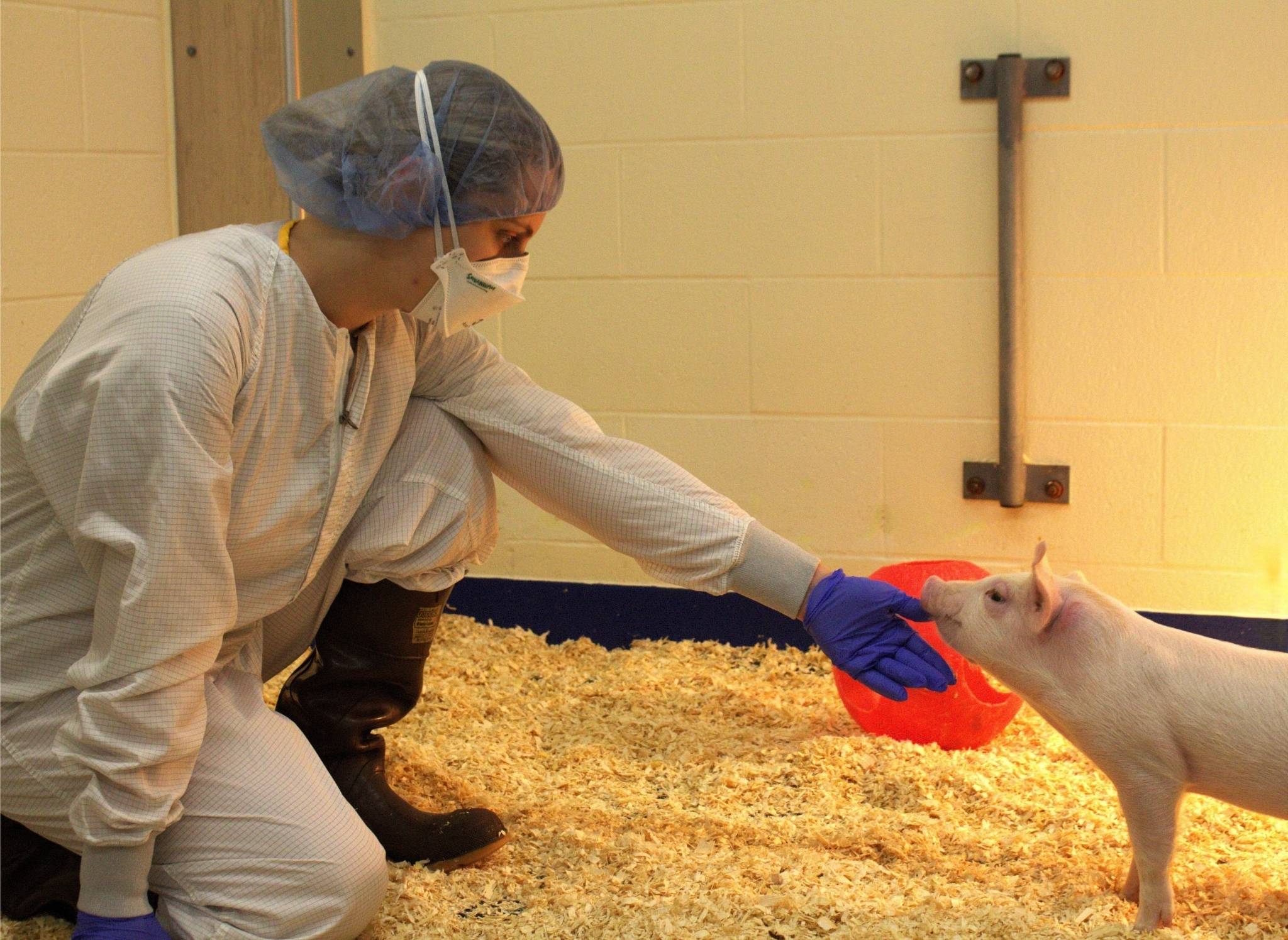
The Invisible Bond: Research and Empathy
By: Angie Magana, PhD student, Department of Veterinary Pathology, Western College of Veterinary Medicine
(Winner, Research in Action)
This image captures a moment of deep connection between a researcher who faces the challenge of obtaining answers to scientific questions while providing the best care to an animal. Animal welfare and ethics are the foundation of our entire process, from the planning and execution of the experiment to the results interpretation. Our priority as a researcher is to always provide a safe and enriched environment that keeps our animals in the best possible mood and health. This research aims to understand how maternal derived antibodies protect piglets against the swine influenza virus.
Funding: Government of Saskatchewan, NSERC, Secretaría Nacional de Ciencia, Tecnología e Innovación (SENACYT)
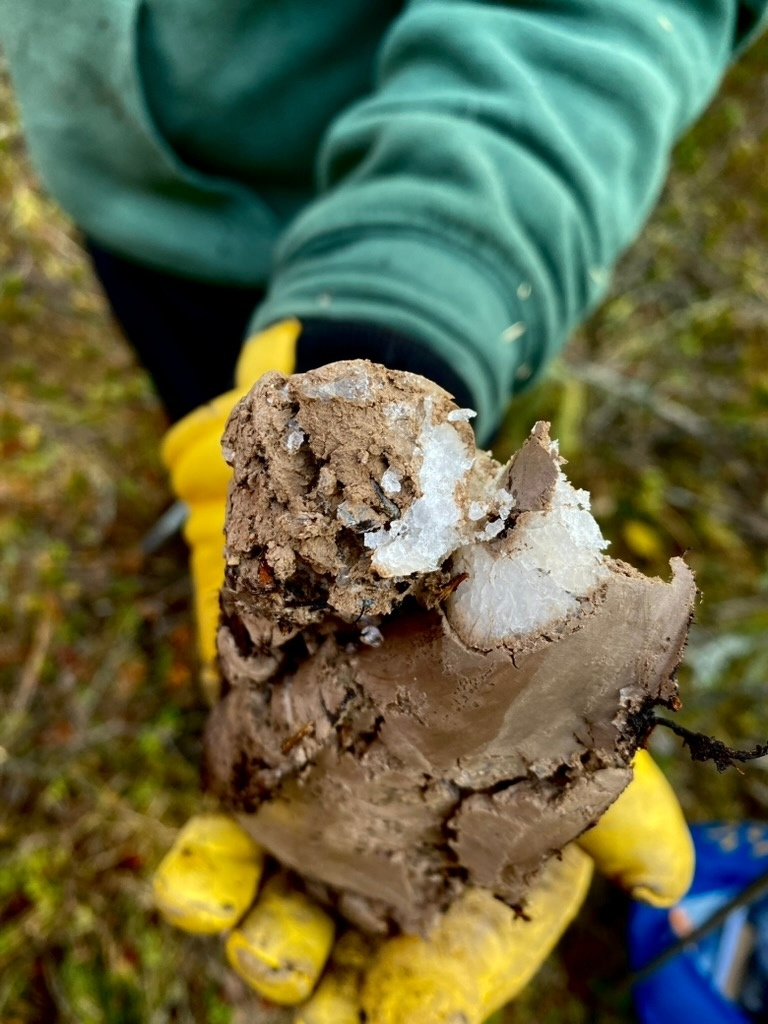
Permafrost: More than Meets the Ice
By: Alana Muenchrath, PhD student, School of Environment and Sustainability
(Runner-up, Research in Action)
Clear, crystalline ice stands out against a handful of frozen soil, revealing a hidden layer of northern ecosystems—permafrost. This sample was taken beneath our feet during a field campaign near Yellowknife, Northwest Territories, offering insight into the hidden subsurface world. As global temperatures rise, ground ice like this will melt, destabilizing the landscape, releasing stored soil carbon, and reshaping northern ecosystems. Through permafrost mapping and monitoring of thaw, our research aims to improve predictions and inform strategies for adapting to a changing environment.
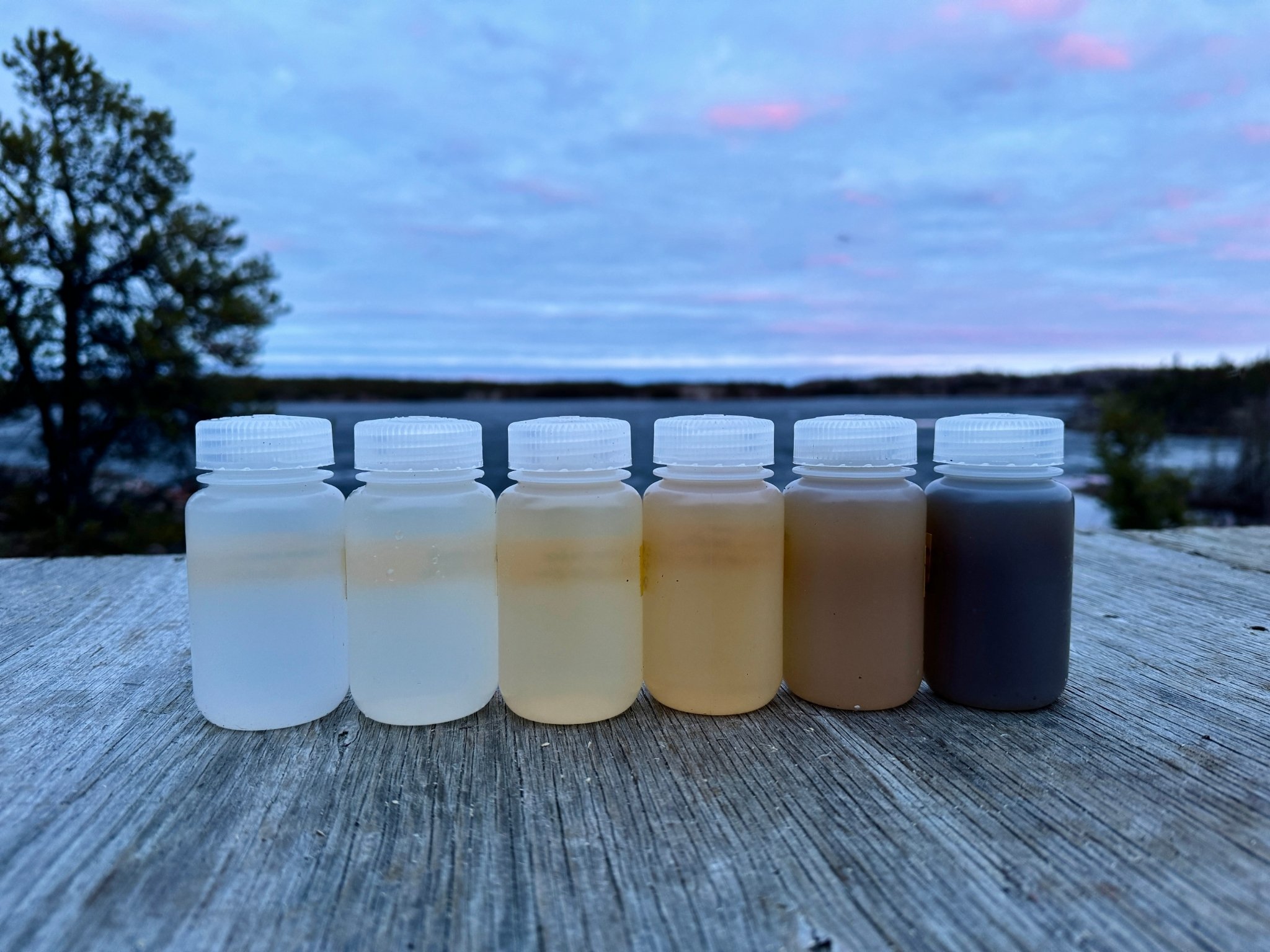
Subarctic Secrets: What Water Samples Reveal About Changing Carbon Flow
By: Aram Jalali Bouraban, PhD student, School of Environment and Sustainability
(Winner, From the Field)
These water samples are more than just different shades; they tell the story of how Arctic and subarctic landscapes release carbon as water flows into streams. As rainwater flows through rocky slopes, peatlands, and forests in the Taiga Shield ecoregion of NWT, it gathers dissolved carbon and carries it into rivers and lakes. Darker samples come from carbon-rich peatlands, while clearer ones suggest water from forest soil, lakes, or precipitation. But as the region warms, shifting water pathways are changing how much carbon landscapes send to streams and lakes—potentially increasing carbon release into the atmosphere, accelerating climate change, and posing a threat to regional and global sustainability.
Funding: Environment and Climate Change Canada (ECCC)

Sideline Surveillance:
Observing Canadian Police Officers
By: Britt Hendry, PhD student, Department of Educational Psychology and Special Education, College of Education
(Runner-up, From the Field)
Police officers experience immense psychological, physical, and emotional demands in their work, which contribute to decreased levels of job satisfaction. But what exactly are those demands and how can we measure their impact? To identify and understand these demanding aspects of work, I entered the field to investigate. I rode-along with numerous police officers across Canada to better understand their duties and responsibilities. By gaining insight into the challenges of policing, targeted efforts can be recommended that will preserve a satisfied workforce who make positive contributions to their communities. This photo represents the unique insider-outsider position I felt as a researcher studying first responders in the field – where academia and the front line collide.
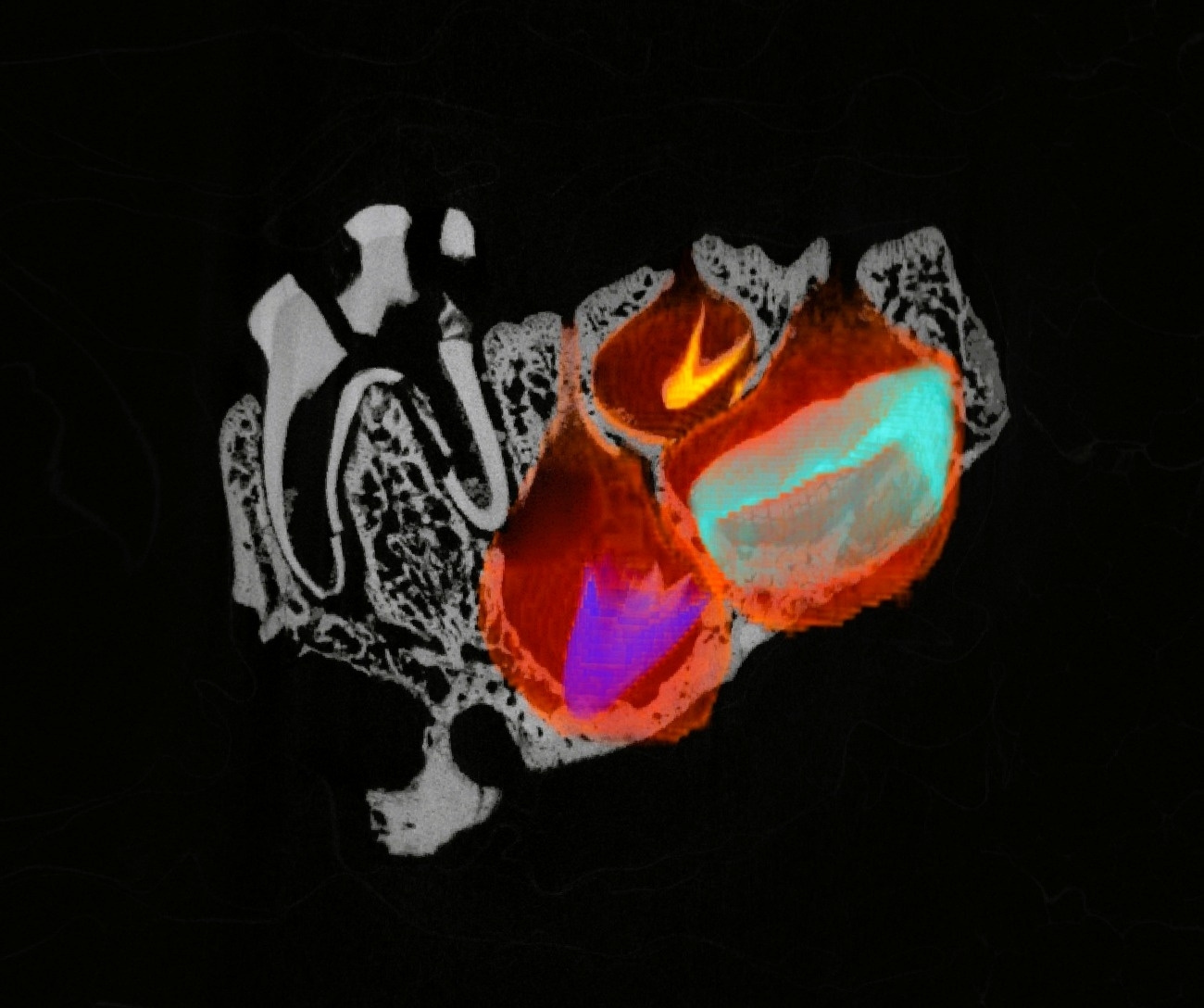
Frozen in Time: Teeth that Never Came to Bite
By: Amalya Babayan, Master’s student, Department of Anatomy, Physiology and Pharmacology, College of Medicine
(Winner, Best Description)
Two million years ago, a child was growing—until time stopped. This CT scan captures the arrested development of a young Paranthropus robustus, revealing the hidden world inside its fossilized jaw. The red pockets trace the spaces carved in jawbone, with eruption paths stretching and tunneling towards the surface. The cyan, yellow, and violet shapes—adult incisors and a canine—never emerged. As soft tissue deteriorated, teeth shifted. The tilted teeth sat patiently for two million years, waiting to be discovered. Found in the Cradle of Humankind, this jaw fragment offers a rare glimpse into how our ancestors grew, just as dentists today track kids’ growth based on their tooth development.
Funding: NSERC - Discovery Grant and CGS-M; La Trobe University Internal Research Grant, Australian Research Council
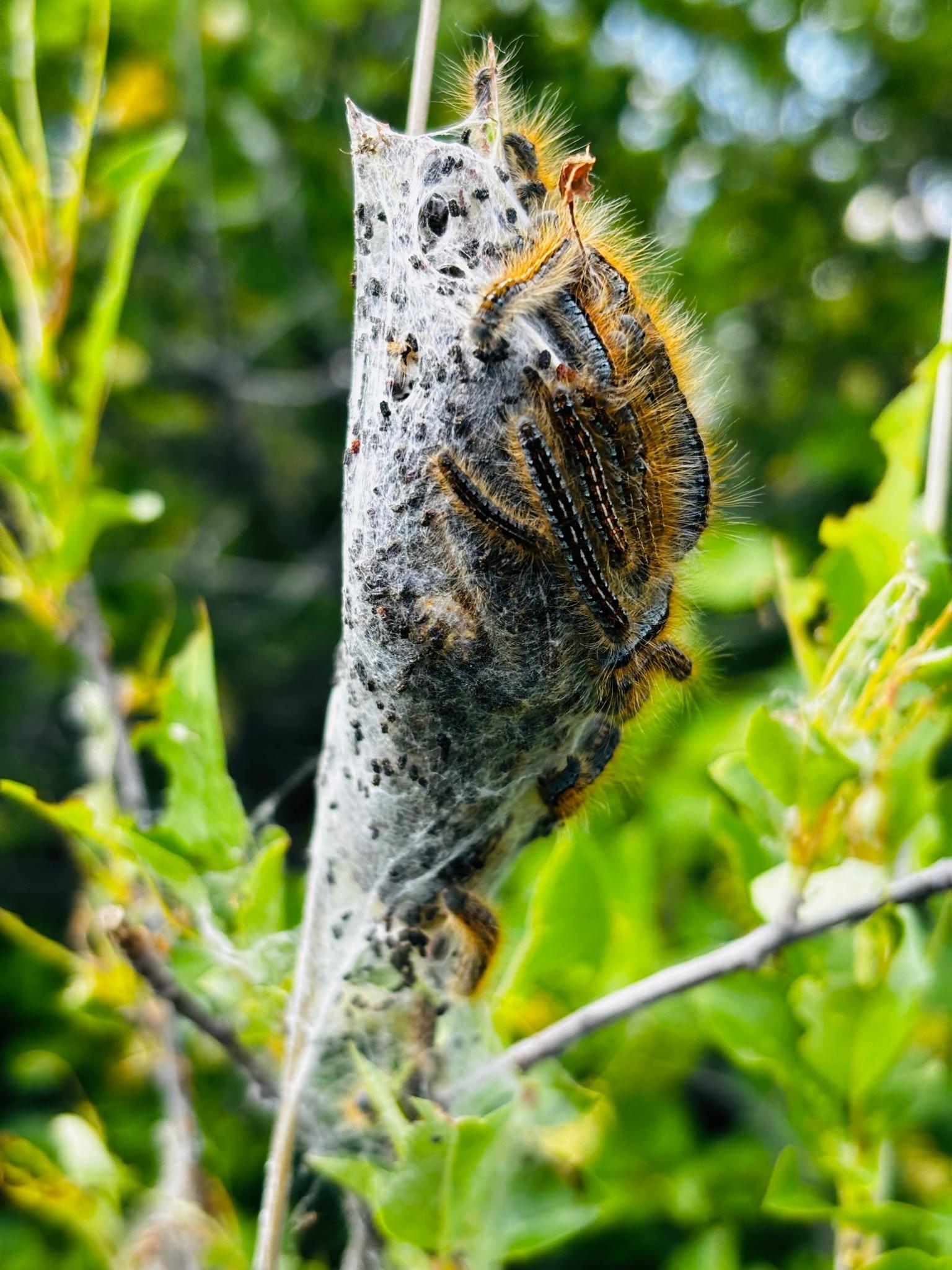
Woven Instincts: The Architecture of Survival
By: Gabriela Sieminska-Hauck, MFA student, School for the Arts, College of Arts and Science
(Runner-up, Best Description)
Cocooning and nest-building are essential biological behaviors, ensuring survival, reproduction, and continuity across species. Insects and animals construct these enclosures not through learned behavior but through inherited instinct—an evolutionary intelligence encoded in their DNA. These structures serve as protective shelters and transformation chambers, marking crucial stages of development. From the silk-laden cocoons of caterpillars to the intricate nests of birds, each species demonstrates a remarkable ability to engineer spaces that safeguard the next generation. Through photography, these ephemeral architectures reveal nature’s meticulous design, offering insights into the transmission of survival strategies. Research on these behaviors bridges biology and cognition, illustrating the deep ties between instinct, memory, and the genetic wisdom that shapes life across generations.
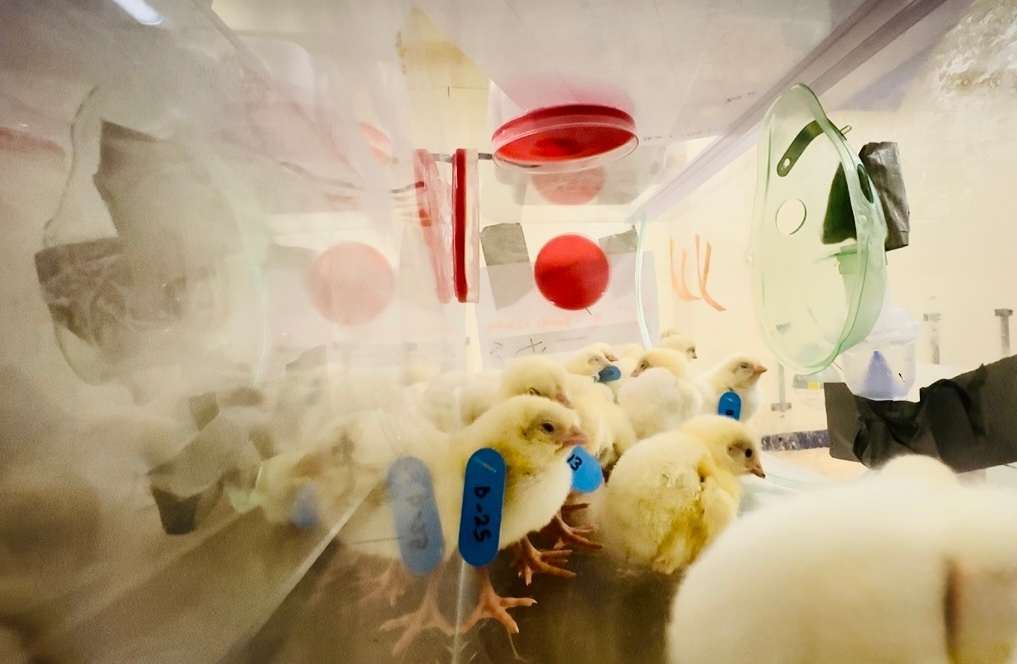
A Breath of Protection!
By: Mihiprabha Rathnayake, PhD student, Department of Veterinary Pathology, Western College of Veterinary Medicine
(Winner, Viewers' Choice)
A delicate cloud of mist swirls inside the transparent chamber as a group of fluffy chicks curiously huddled together, receiving their first shield of protection. The soft golden down of the chicks glows under the light as the nebulizer gently disperses a synthetic DNA molecule called CpG-ODN, ensuring each tiny breath caries a promise of immunity. These young lives embark on their journey with a breath of protection, laying the foundation for a healthier life in a world with challenging pathogenic bacteria like E. coli and C. perfringens.
Funding: RDAR, NSERC CRSNG, Mitacs, Chicken Farmers of Saskatchewan, Canadian Poultry Research Council, Government of Saskatchewan - Ministry of Agriculture

Glows in the Darkness
By: Angie Magana, PhD student, Veterinary Pathology, Western College of Veterinary Medicine
(Runner-up, Viewers' Choice)
When we think of the final suffering of a living being, a feeling of sadness overwhelms us. However, some diseases produce images that are as beautiful as they are lethal. The photo shows a histological section of a dog's kidney that was poisoned with ethylene glycol. This chemical, used as a car coolant, causes the deposition of calcium oxalate crystals in many organs and has a sweet taste, making it attractive to animals. The irregular structure of the crystals splits the light passing through them, generating a spectrum of colors similar to that of a rainbow, in a phenomenon known as birefringence.

